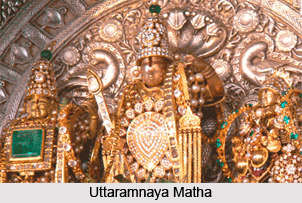 Four mathas of Shankaracharya is traditionally said to have established by Adi Sankaracharya of 8th century in India. These Maths (Monastries) were said to have placed under the leadership of Adi Sankaracharya`s four chief disciples. In honour of the founder, the heads of these four and the Dasanami orders monasteries have come to be known as Sankaracharyas themselves.
Four mathas of Shankaracharya is traditionally said to have established by Adi Sankaracharya of 8th century in India. These Maths (Monastries) were said to have placed under the leadership of Adi Sankaracharya`s four chief disciples. In honour of the founder, the heads of these four and the Dasanami orders monasteries have come to be known as Sankaracharyas themselves.
They are well thought-out to be the leaders of the ten orders of the Dasanami Sannyasins, who follows the Advaita Vedanta. The primary eastern (Purvamnaya), southern (Dakshinamnaya) and western (Pascimamnaya) establishments are based at Puri (Orissa), Sringeri (Karnataka) and Dwaraka (Gujarat) respectively. Close to the pilgrimage town of Badrinath the northern (Uttaramnaya) Sankaracharya is seated at Jyotirmath also known as Joshimath.
The history of `Uttaramnaya matha` is exceedingly complicated. In the 18th century, after the period of one Swami Ramakrishna Tirtha, according to an official accounts, the Uttaramnaya matha had no existence for about 165 years. Under the headship of Swami Brahmananda Saraswati, Uttaramnaya matha was resurrected in 1941.
In 1941, Swami Brahmananda Saraswati was appointed by a group of monks and pundits based in Varanasi (the Bharata Dharma Mahamandala, Kashi Vidvat Parishad, and the Akhila Bharatiya Dharmasangha), with the consents of Swami Bharati Krishna Tirtha, the then Sankaracharya of Puri. Swami Chandrasekhara Bharati of Sringeri also certified Brahmananda`s appointment.



















